Are you a job seeker in the customer support arena grappling with the same hurdle? You’re not alone! Many job seekers in customer support roles find it challenging to showcase their people skills, efficiency, and professionalism on a single-page customer service resume. Even with solid practical experience, it can be tough to make your achievements stand out in the eyes of hiring managers or pass automated screening systems.
As hiring trends evolve and applicant tracking systems (ATS) filter applications, crafting a strong customer service resume that demonstrates empathy, problem-solving, and communication within strict formatting rules can be overwhelming, especially when competing against a flood of similar resumes.
This guide offers proven strategies for professionals across retail, call centers, hospitality, finance, healthcare, and technology. It covers every aspect—from formatting and keyword use to measurable metrics and skills integration—to help job seekers create a customer service resume that commands attention and earns callbacks.
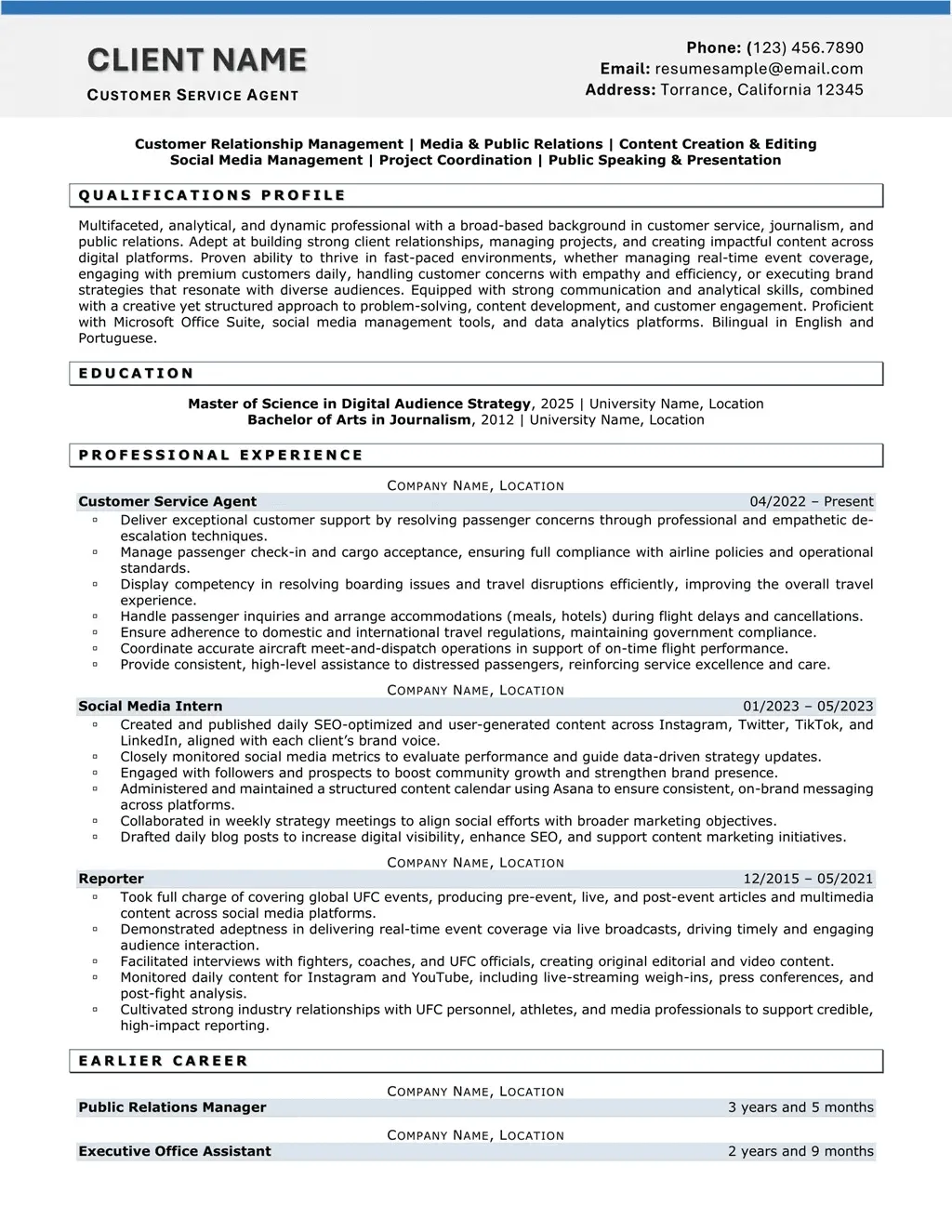
Essential Purpose of a Customer Service Resume
A customer service resume serves as the candidate’s first impression, combining professionalism with a demonstration of empathy and reliability. This document should go beyond listing duties to showcase how the applicant improves customer satisfaction, resolves issues, and contributes to company goals. Recruiters expect concise storytelling that reflects understanding of consumer needs and adaptability in fast-paced environments.
Every employer relies on customer experience to maintain brand loyalty. According to the U.S. Bureau of Labor Statistics, customer service occupations account for over 2.8 million positions nationwide, and competition continues to increase. A resume that powerfully aligns with company culture and communicates tangible results proves indispensable. For instance, rather than writing “handled calls,” high-performing candidates specify “resolved 95% of customer complaints on first contact,” quantifying the effect of their actions.
Resumes are evaluated not just by human recruiters but by ATS software that scans for relevance. Effective resumes mirror the language of job descriptions, embedding industry-relevant keywords such as “CRM systems,” “customer satisfaction improvement,” “issue escalation,” or “cross-functional collaboration.” Strategic keyword alignment ensures both machine readability and recruiter engagement, positioning candidates at the top of shortlists.
Best Formatting and Structure Practices for Modern Customer Service Resumes
Organization and readability define resume effectiveness. A customer service resume should employ a clean, ATS-friendly layout, ensuring content clarity across digital platforms. The reverse-chronological format remains most common due to its logical flow: beginning with current experience, followed by older roles, education, and specialized skills. However, combination formats—mixing a skills summary with chronological experience—work well for candidates transitioning careers or returning from employment gaps.
Each section should showcase key elements that hiring managers prioritize. The structure generally includes:
- Header: Presents full name, contact information, professional title, and location. Linking to a professional LinkedIn profile adds credibility.
- Professional Summary: A concise, three-to-four-sentence overview summarizing career highlights and customer-facing strengths.
- Key Skills: Lists hard and soft skills matched to the target job description—examples include conflict resolution, data entry accuracy, empathy, or CRM proficiency.
- Work Experience: Describes duties in active verbs and quantifies outcomes (e.g., “Increased retention by 12% through improved call resolution procedures”).
- Education and Certifications: Details academic degrees or specialized training such as “Customer Experience Certification” or “Service Excellence Award.”
Visual clutter undermines professionalism. Limiting color use, avoiding icons that ATS cannot parse, and maintaining consistent font styles reinforce visual credibility. Hiring analysts find that resumes scanned in six seconds generally lead with impactful summaries and clearly labeled sections. Strategic white space keeps recruiters focused and supports smooth eye movement throughout the document.
Elements of Compelling Professional Summary
The professional summary introduces the candidate’s value proposition in roughly 75–100 words. It should blend motivation, technical proficiency, and personality. Customer service employers seek detail-oriented professionals who cultivate trust and efficiency. Therefore, summaries that begin with a strong action-oriented statement tend to perform best.
Effective summaries typically include four elements: career title, years of experience, specialty areas, and measurable impact. For example: “Dedicated Customer Support Specialist with five years of experience managing high-volume inquiries in telecommunications. Skilled in CRM optimization, issue escalation management, and first-contact resolution. Recognized for achieving 98% satisfaction scores while mentoring new hires.” A version like this attracts both human and automated attention simultaneously, boosting search relevancy within application systems.
In AI-enhanced recruitment environments, contextual storytelling complements data precision. Summaries emphasizing adaptability and emotional intelligence resonate strongly with hiring managers in hybrid workplaces. Positioning statements such as “Driven to uphold brand reputation through personalized care” signal long-term cultural compatibility—an increasingly weighted factor in modern candidate assessments.
Key Skills Every Customer Service Resume Should Include
Employers prioritize a mix of interpersonal, technical, and operational skills in customer service roles. These skills indicate whether candidates can multitask effectively, maintain empathy under pressure, and leverage technology to resolve issues efficiently. Distinguishing between hard and soft skills ensures balanced representation of professional competencies.
| Hard Skills | Soft Skills |
|---|---|
| CRM Software (Salesforce, Zendesk) | Empathy and Active Listening |
| Data Entry and Multichannel Communication | Patience and Emotional Regulation |
| Call Documentation and Ticket Tracking | Problem Solving |
| Knowledge Base Management | Collaboration |
| Performance Metrics Interpretation | Adaptability and Conflict Resolution |
Resumes that cluster skills into functional categories perform better during ATS screening. For example, a section titled “Technical Proficiencies” may highlight CRM systems, MS Office Suite, or help-desk ticketing software. Meanwhile, “Interpersonal Skills” can demonstrate reliability, teamwork, and integrity. Companies increasingly test emotional intelligence during interviews; thus, describing how such skills translate into business outcomes reinforces credibility.
Customer support centers often invest heavily in training employees on performance metrics like resolution time, Net Promoter Score (NPS), and customer satisfaction rate (CSAT). Applicants who translate experience into quantifiable figures—such as “Reduced average wait time from 4 minutes to 2”—signal both awareness of performance standards and initiative in improvement efforts. Quantitative evidence remains one of the strongest differentiators on a modern customer service resume.
How to Write Impactful Work Experience Descriptions
The experience section transforms job duties into accomplishments. Hiring managers rely on measurable examples to determine impact. Each entry typically begins with a strong action verb and concludes with results. Using concise bullet points encourages readability while ensuring ATS compatibility.
- Manage and resolve 60+ inbound queries daily through phone and chat while maintaining 98% satisfaction rating.
- Collaborate with cross-functional support team to streamline process efficiency, shortening response time by 30%.
- Train and supervise junior representatives in company protocols, improving first-call resolution from 70% to 90%.
- Handle billing disputes and account escalations, consistently exceeding retention targets through solution-focused negotiation.
- Assist department managers in analyzing customer feedback trends to design service improvements.
Employers reviewing hundreds of resumes daily naturally prioritize those linking achievements to business metrics. Highlighting quantifiable context transforms generic entries into performance statements that command authority. For instance, “Assisted customers daily” lacks significance compared to “Supported an average of 100 customers per shift while maintaining department-best retention rates.” Precision signals accountability and professionalism.
Modern customer service resumes benefit from integrating digital literacy achievements such as chat support automation or CRM data analysis. With virtual communication channels expanding, experience involving omnichannel support—across phone, email, live chat, and social media—indicates broad adaptability. This is particularly advantageous for hybrid or remote contact center environments where technological competency equals customer satisfaction.
Highlighting Education and Certifications
While most customer service positions do not require advanced degrees, education reflects intellectual consistency and learning capacity. High school diplomas or associate degrees often suffice, though candidates with bachelor’s degrees in communication, business, or psychology can leverage academic training to signal advanced understanding of consumer interaction.
Certifications strengthen credibility, particularly in specialized sectors. Recognized credentials such as the International Customer Service Association (ICSA) Certification or HDI Customer Service Representative Certification demonstrate dedication to constant improvement. Many professionals also complete technical workshops in CRM management, call-handling systems, or service analytics, supporting career advancement into supervisory or operations roles.
Educational sections should remain succinct. Employers prioritize hands-on results, so degrees and certifications appear below work experience unless they directly relate to the job target. Resumes emphasizing continued learning—like participation in company-sponsored leadership programs—communicate growth readiness and dedication to service excellence.
ATS Optimization Strategies for Customer Service Resumes
Modern recruitment relies heavily on applicant tracking systems to filter applicants efficiently. ATS scans each resume for keyword alignment, formatting consistency, and job-related skill sets. A misaligned resume risks rejection before reaching a recruiter’s desk. Optimizing content ensures visibility during this automated stage.
ATS-friendly resumes maintain minimal formatting complexity. Avoiding tables for text sections, inserting standard headings like “Work Experience,” and integrating exact keywords maximize system compatibility. For example, if a posting lists “customer complaint management,” the phrase should appear verbatim within either a bullet point or summary section.
- Mirror job descriptions: Align resume phrasing with the advertised role for optimal scanning.
- Use standard fonts and plain text: ATS often fail to read icons, images, or stylized fonts.
- Include both acronyms and full forms: Write “Customer Relationship Management (CRM)” for broader keyword reach.
- Save as PDF or Word: Most ATS handle these formats reliably.
- Emphasize transferable metrics: Highlight customer satisfaction data or resolution percentages that resonate across industries.
According to recent HR analytics reports, resumes with precise keyword density of around 1–2% correlate with higher matching scores. Overstuffing keywords, however, can decrease readability and authenticity. The strongest resumes balance automation compliance with persuasive human appeal—ensuring human reviewers remain engaged after the software screening.
Examples of Customer Service Resumes with Strong Summaries
1. Customer Service Representative
Highly motivated, analytical, and detail-oriented professional with strong communication skills and a commitment to delivering exceptional customer service and operational excellence. Competent in handling complex inquiries with precision, resolving issues with professionalism, and providing accurate information to ensure optimal outcomes and efficiency.
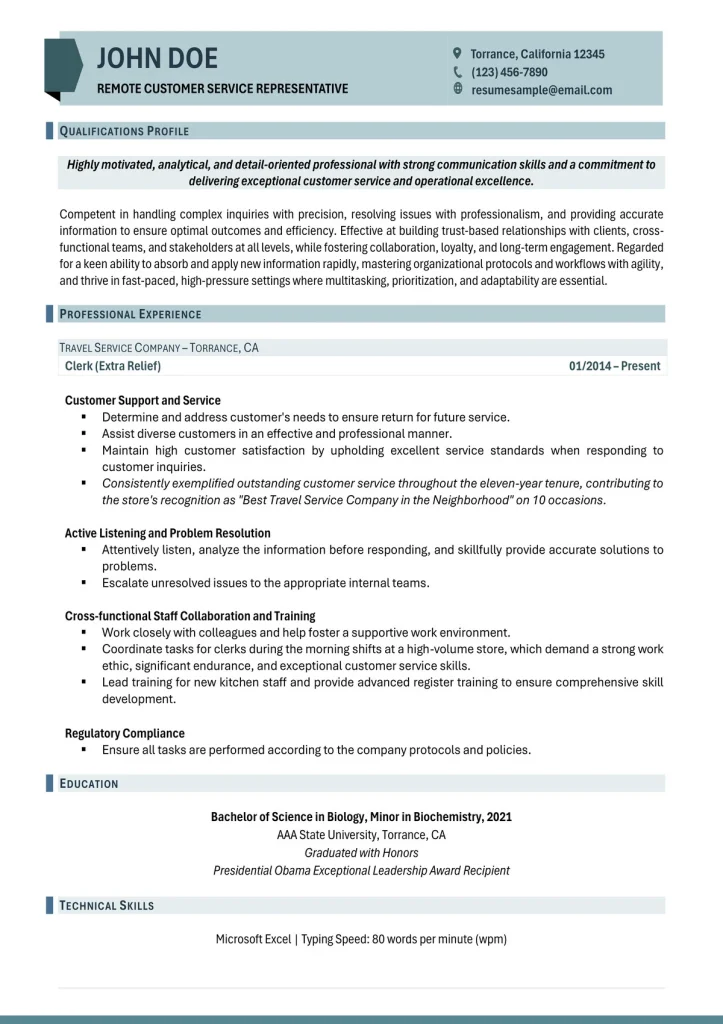
2. Call Center Supervisor
Results-focused, forward-thinking, and service-driven professional with extensive experience in client services operations management. Adept at managing complex escalations, analyzing data to drive efficient resolutions, and ensuring high customer satisfaction. Skilled at mentoring teams, optimizing workflows, and handling high-volume tasks while maintaining quality and accuracy.

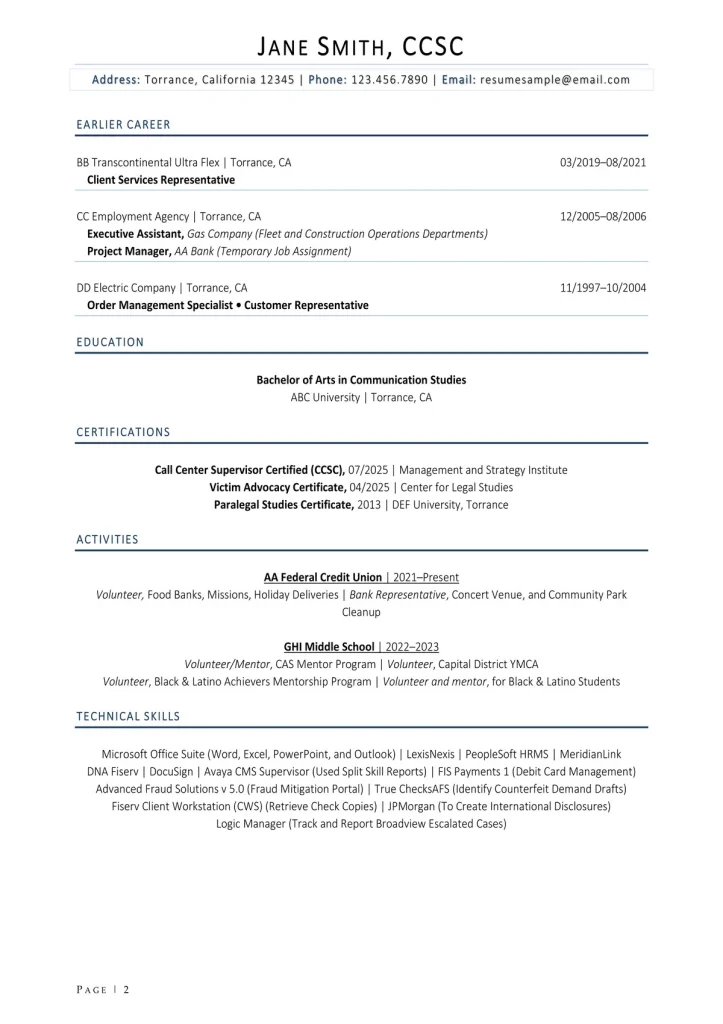
3. Customer Success Specialist
Dynamic, customer-centric, and results-driven professional, with broad-based experience in account management, customer service relations, and new business development. Proficient in utilizing customer relationship management (CRM) systems and Microsoft Office Suite to improve customer experience and boost customer loyalty, repeat business, and sales.

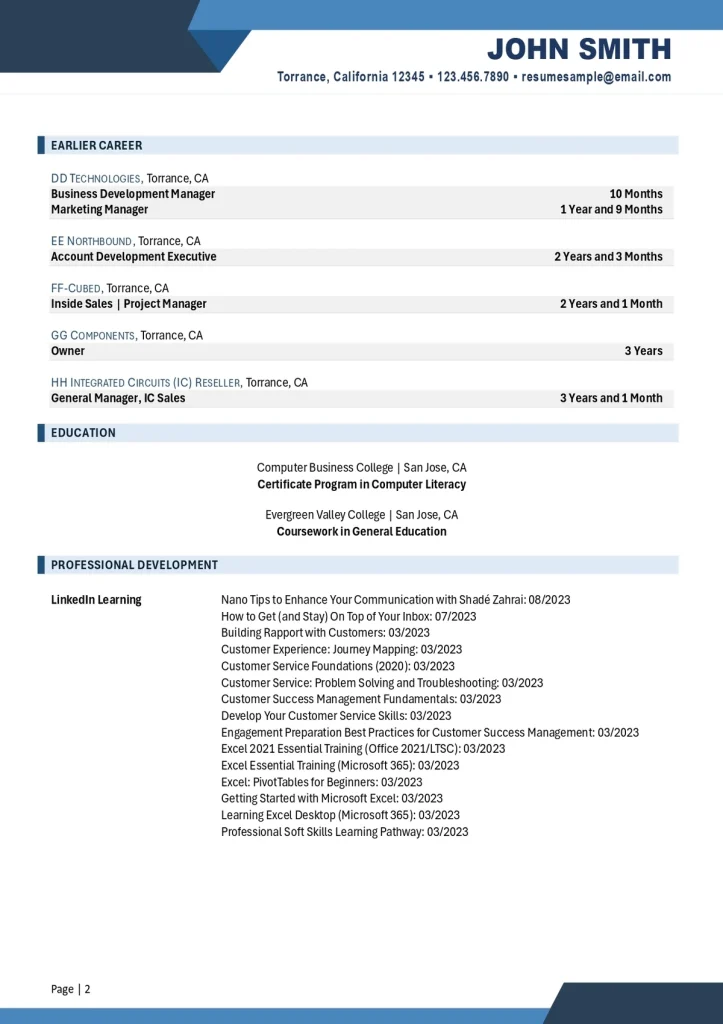
4. Hospitality Service Manager
Forward-thinking and accomplished professional with extensive experience in leading customer receptions and guest relations operations across the hospitality industry. Expert at optimizing day-to-day operations, driving profitability, and elevating guest satisfaction through strategic planning, team development, and service excellence advocacy.
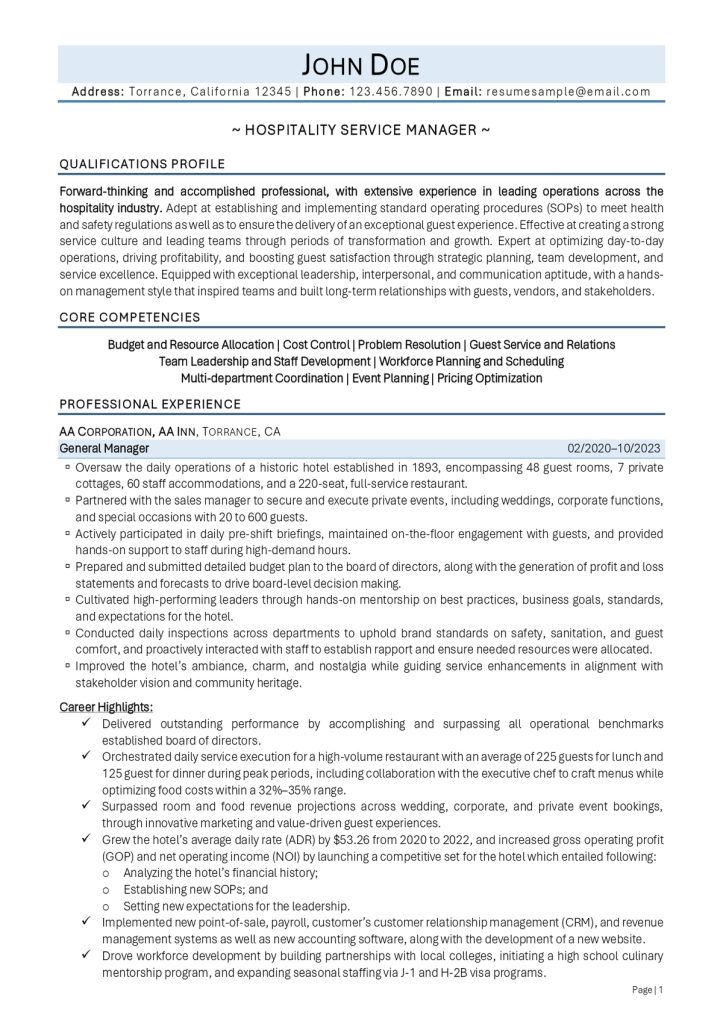
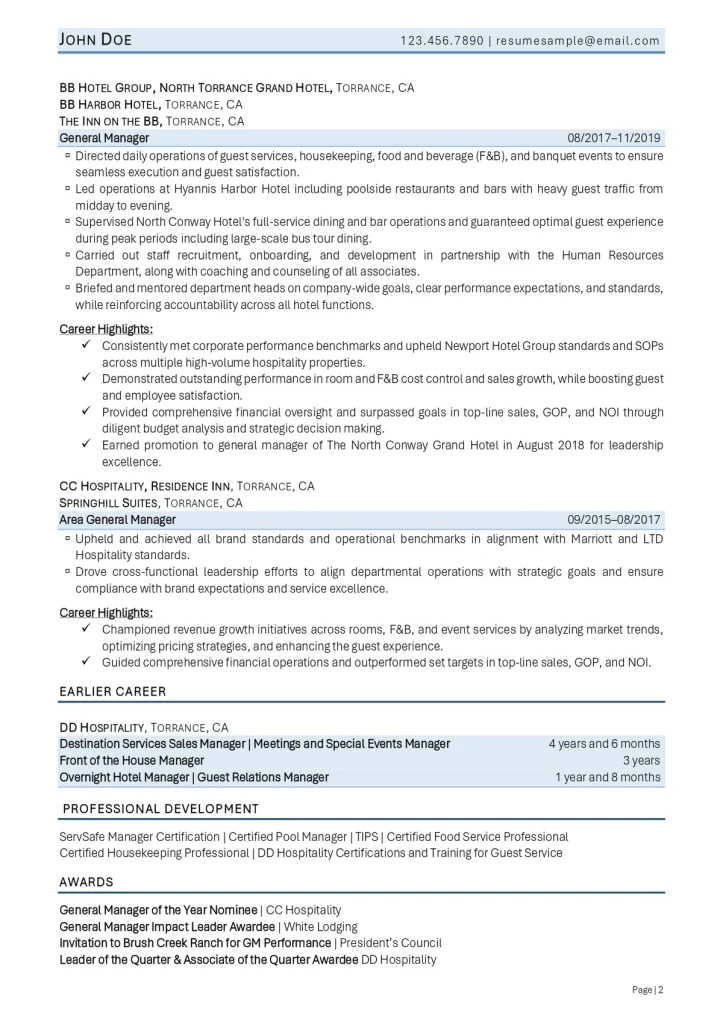
5. Technical Support Representative
Analytical and highly dedicated technical support professional with years of experience resolving complex hardware and software issues in high-pressure environments. Renowned for relentless commitment to problem-solving and customer satisfaction, with a strong track record of turning around difficult customer situations and diagnosing rare technical issues.

Each example integrates measurable achievements and role-specific terminology that pleases both ATS and human reviewers. Emphasizing results and measurable contributions supports applicant credibility and reflects strong alignment with hiring objectives.
Common Mistakes to Avoid in Customer Service Resumes
Even strong candidates fail to advance when key fundamentals are overlooked. The following missteps frequently lead to missed opportunities:
- Overly generic language: Phrases like “responsible for customer support” lack measurable depth.
- Neglecting metrics: Hiring managers prefer data-driven statements demonstrating quantifiable improvements.
- Poor formatting: Dense paragraphs and inconsistent spacing reduce readability and ATS compatibility.
- Irrelevant information: Listing outdated jobs or unrelated hobbies dilutes professional focus.
- Misaligned tone: Emotional or overly casual phrasing can appear unprofessional and mismatch brand standards.
Resumes must communicate achievements objectively while aligning with the cultural tone of potential employers. Professionals aiming for leadership or escalation specialist roles should adopt formal diction and emphasize business outcomes rather than routine tasks. Tailoring content toward organizational impact rather than personal goals demonstrates maturity and customer orientation.
Showcasing Transferable Skills and Achievements
Customer service roles often serve as launchpads to management, sales, marketing, or operations. Job seekers changing industries should use transferable skills to connect previous experience with prospective responsibilities. For example, former educators may highlight relationship-building and crisis management as transferable competencies applicable to customer support leadership.
Employers increasingly value proof of adaptability—whether transitioning from front-line service to client relations or from retail to SaaS support. Demonstrating accomplishments such as “led training sessions that reduced escalation tickets” connects interpersonal skill with measurable efficiency. Incorporating action verbs like “initiated,” “coordinated,” and “enhanced” further defines capability and initiative.
Digital tools built into CRM systems also support achievement articulation. Reports can quantify improvements in customer experience metrics, enabling professionals to cite verified results. Cross-referencing team or departmental performance benchmarks provides objective grounding. The goal remains to validate claims through context, demonstrating clear value to employers seeking service excellence.
Career Progression and Salary Outlook in Customer Service
Customer service professionals can advance into a wide range of specialized or supervisory positions. Career development often includes promotions to customer experience manager, contact center supervisor, or operations coordinator. Many later transition into business development, training, or account management depending on skill application and company structure.
Salary potential varies by sector and experience level. The average national pay for customer service representatives, according to data from the U.S. Bureau of Labor Statistics, exceeds $46,000 annually, with bonuses and incentives often linked to performance metrics. Professionals managing teams or technical help desks typically earn 20–40% more based on responsibilities and certifications.
Professionals planning long-term careers within customer experience management should pursue analytics-driven and leadership training. Courses in emotional intelligence, communication strategy, data interpretation, and AI chatbot system integration are becoming valuable career multipliers. Combining human-centered empathy with technology fluency will remain critical through future employment cycles.
Building a Resume That Reflects Professional Growth
Long-term customer service success depends on demonstrating upward mobility. Even entry-level professionals should highlight leadership potential within daily roles, whether through mentoring new team members or managing specific quality improvement initiatives. Hiring managers consistently favor evidence of consistent progress over static experience listings.
Job seekers can reflect progression by organizing work entries to emphasize growing levels of accountability, achievements, and scope. For example, describing a promotion by specifying “advanced from Associate to Senior Service Representative within 18 months due to surpassing retention goals” presents tangible momentum. This combination of accountability and ambition resonates deeply within recruitment contexts.
Pairing achievement metrics with career narrative makes the resume feel both factual and goal-oriented. Tools like skill matrices or succinct footnotes under job entries can efficiently demonstrate continuous competence development. Showcasing quantifiable professional evolution reassures employers of long-term value beyond initial training investment.
Writing Effective Cover Letter to Support the Resume
An accompanying cover letter allows candidates to articulate motivation and alignment with company mission. This brief narrative connects the technical accuracy of the resume with personality, cultural fit, and enthusiasm. While optional in some sectors, personalized cover letters significantly increase engagement rates when addressing customer service positions emphasizing communication skill.
Each letter should include the following structural flow:
- Introduction summary of professional background;
- Evidence-based paragraph describing customer satisfaction achievements; and
- Closing statement detailing commitment to company service objectives.
Personalize the content by referencing the employer’s reputation or customer experience philosophy demonstrates initiative and sincerity.
Resumes secure visibility, while cover letters secure connection. Together, they reinforce both technical competence and intrinsic motivation—hallmarks of customer service success recognized universally among U.S. employers.
Revamp Your Resumes with Professional Expertise for Maximum Impact
A standout resume remains the foundation for advancing in customer service careers. By incorporating measurable metrics, customer-centric storytelling, and ATS-friendly formatting, candidates can differentiate themselves even in saturated markets. Those seeking a competitive advantage often rely on professional resume writers who blend industry insight with compelling narrative structure to produce resumes that meet recruiter expectations and elevate career prospects.
Frequently Asked Questions
What should a customer service resume summary include?
A customer service resume summary should briefly highlight experience level, technical proficiencies, and customer interaction achievements. Including metrics such as satisfaction ratings or response-time improvements makes the summary impactful and results-oriented.
Which skills are most valuable for customer service roles?
The most valuable skills include communication, empathy, problem solving, CRM knowledge, conflict resolution, and multitasking. Employers also appreciate data interpretation and technological adaptability in remote and hybrid environments.
How long should a customer service resume be?
Most professionals maintain a one-page document unless holding over 10 years of progressive experience. Mid-level or managerial candidates may extend to two pages, provided all content remains relevant and measurable.
What is the best resume format for customer service professionals?
The reverse-chronological format works best. It highlights recent responsibilities, allowing recruiters to gauge present relevance. Combination formats suit career changers emphasizing specific skill sets or certifications.
Do employers prefer certified customer service professionals?
Certifications, while not mandatory, demonstrate initiative and commitment to career growth. Employers often consider certifications like HDI or ICSA credentials as indicators of advanced professionalism and process knowledge.








